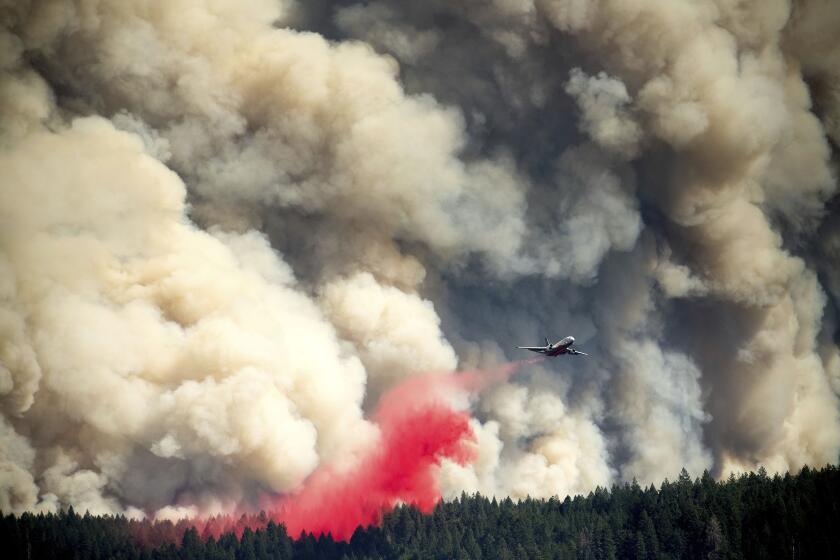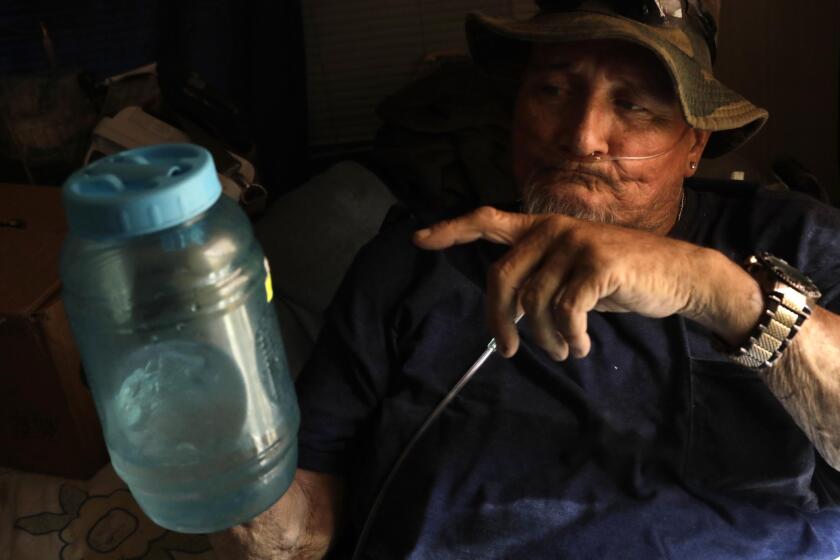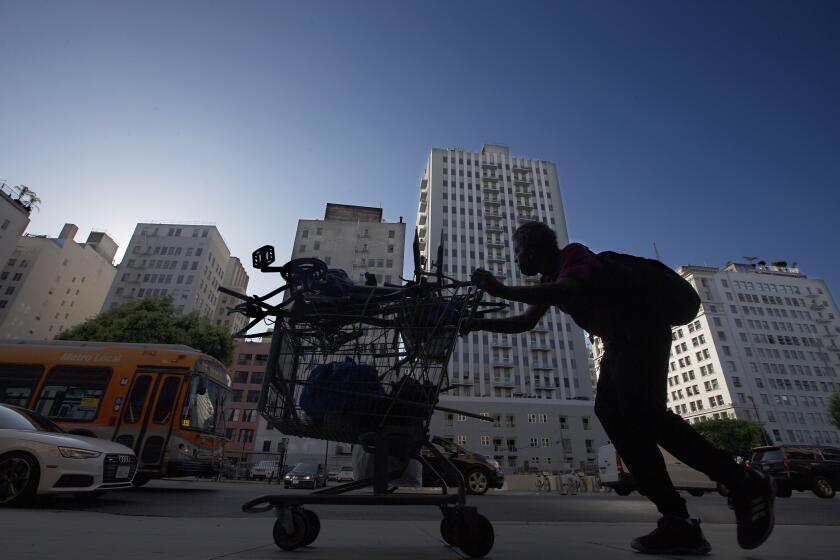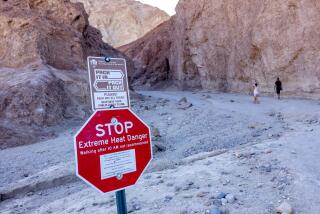Column: Could extreme heat be just what California needs to finally solve homelessness?
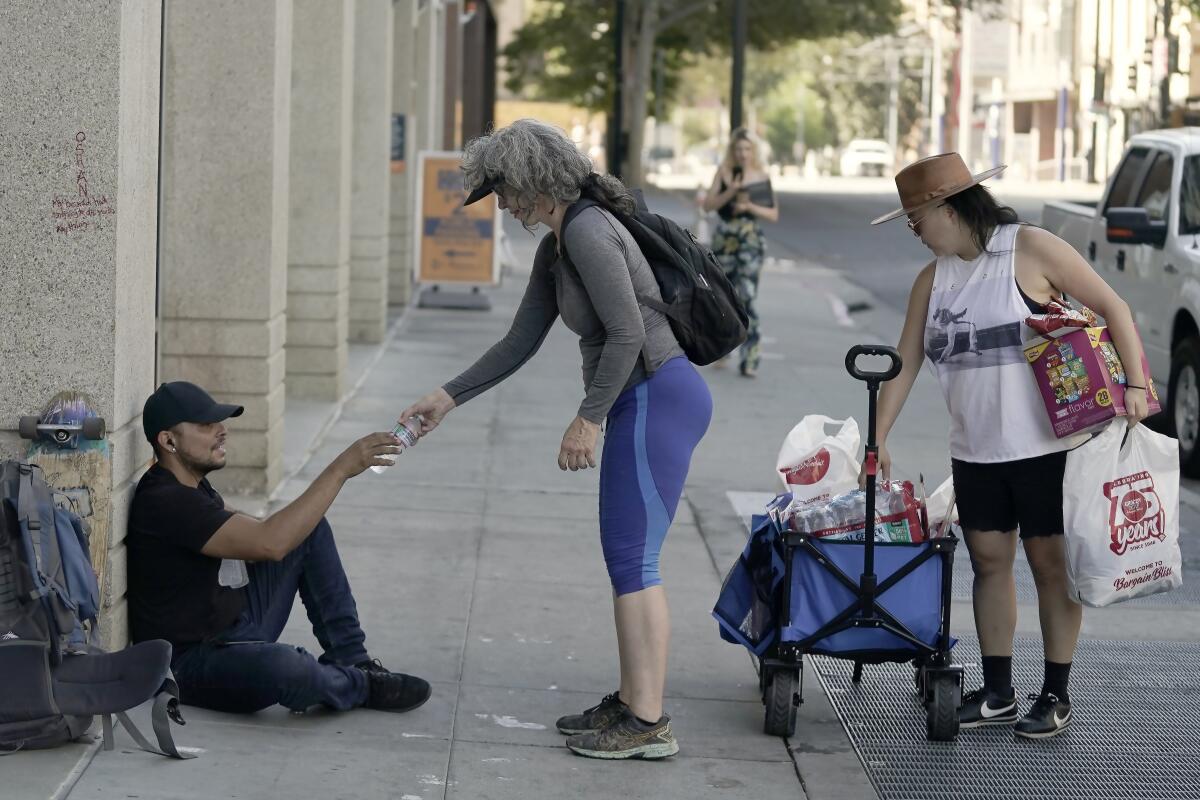
- Share via
As the temperature edged past 110 one afternoon last week, the air inside L’aMaira Tyson’s sagging nylon tent felt like a blast from an open oven.
“It’s hot out here,” she said with stoic understatement, reclining next to two jugs of bottled water near a freeway overpass and a busy street in Sacramento. “I get through it with God.”
We appreciate her faith, but this encampment felt more like hell than heaven during the worst of the “heat dome” that sent temperatures soaring across California, including a record high of 116 in the capital.
“You can’t breathe,” Tyson said. “It drains you.”
Heat has always made being unhoused harder. But to use that favorite word of our times, this is unprecedented. When the temperature rises to new extremes and stays elevated for days at a time, tens of thousands of homeless people end up at greater risk of heatstroke, cardiac arrest and dehydration.
Unlike in cities on the East Coast and in the Midwest, which rely on a robust network of shelters to spare homeless people from the dangers of extreme cold, cities in the West have long let people languish outdoors in our generally good weather.
But what happens when climate change turns that good weather bad?
Will extreme heat push California to adopt a legal right to shelter or housing to help those who are now baking in the summer and could find themselves shivering in freezing rain and evading floods as winter storms become more intense?
And, if lives are increasingly at stake, does a “right” to be indoors mean a requirement to be indoors?
Already, Los Angeles logs more deaths from hypothermia than many cities in colder regions because more unhoused people live outdoors here than anywhere else in the country.
Record heat is fueling dangerous fires across California, pushing firefighters to the limit and creating ideal conditions for more blazes to spark and spread.
“These days are extreme examples of what is wrong and broken in the first place,” said Sacramento Mayor Darrell Steinberg, a longtime champion for a legal right to shelter and healthcare. “If extreme weather can help drive the change that is necessary, then let’s take advantage of the crisis.”
Across the United States, extreme heat kills more people each year than hurricanes, wildfires and floods. It just doesn’t earn the same attention because those deaths are spread out, taking place in bedrooms, tents and workplaces one at a time, and going uncounted by coroners and health officials.
Last year, a Times investigation found that in California alone, about 3,900 people died of extreme heat between 2010 and 2019 — roughly six times more than the state was reporting — and some hospitals have seen heat-related cases climb for the past 15 years.
Researchers this year found that unsheltered people — especially those with a mental illness — were significantly more likely to end up in the hospital during extreme heat than housed people, based on a study of emergency room admissions.
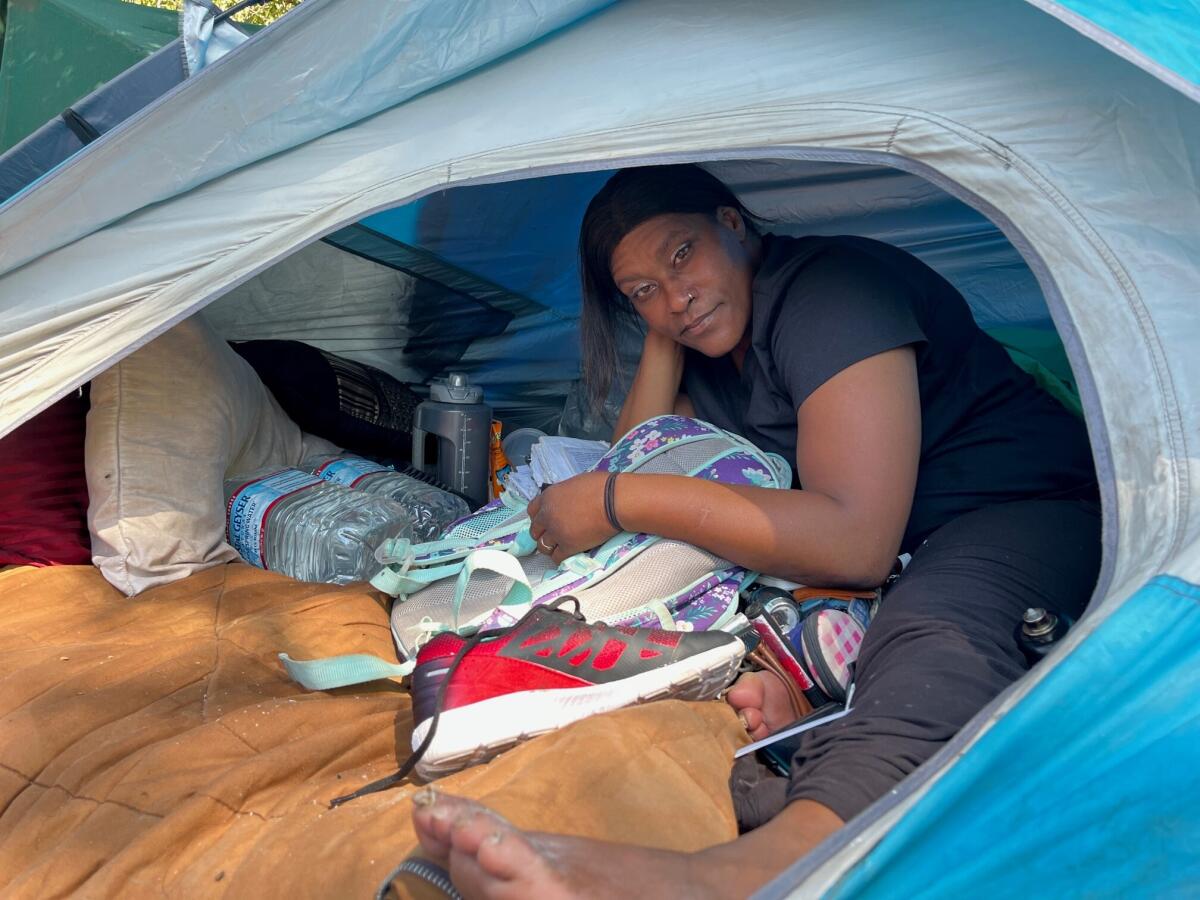
Black people are typically hit the hardest. Like Tyson, who hid in her broken tent for much of last week, too tired and hot to even go search for more water as cars barreled by spewing exhaust. She blamed her misery on the unrelenting direct sun and the pavement mercilessly radiating stored heat.
The disastrous and far-reaching effects of climate change are becoming more apparent with each passing week, all across the country. President Biden’s infrastructure package includes $50 billion to protect against drought, extreme heat and flooding, but that is a meager investment in resilience given the many threats.
Meanwhile, California still doesn’t officially track heat-related deaths, including among the unsheltered, though there are signs that could change. Beyond that, there remains little cohesive momentum for action, besides some early planning and a few aspirational mission statements. This is despite a $37.6-billion climate change package and the $800 million in the 2021 budget meant to reduce urgent risks from extreme heat.
Like so much with homelessness, California’s plan relies on voluntary action from local governments — where the dangers of climate change are too often treated as a passing inconvenience rather than a new normal.
Many cities and counties open cooling centers when temperatures hit certain markers, as they should. Los Angeles did last week, as did Sacramento. But these centers tend to have limited hours and disappear as soon as the heat is no longer extreme, but still dangerous to the most vulnerable people on our streets.
And even this bit of respite is available only where public pressure has made political action necessary.
Read all of our coverage about how California is neglecting the climate threat posed by extreme heat.
Then there are places such as Lancaster in northern Los Angeles County, where about 200 unhoused people are eking out an existence on a smoldering stretch of the Mojave Desert just outside city limits.
Eve Garrow, a policy analyst with ACLU of Southern California, has been advocating on their behalf. Many say, as the Guardian has reported, that they were forced out there by pushy sheriff’s deputies and are now holed up in tents, cars and RVs, miles from the resources they need to survive.
“The weather is very inhospitable,” Garrow said, “and it’s getting hotter.”
Over the weekend, it was in the triple digits. Garrow said she met several homeless people who were nervous about doing anything that would cause physical exertion.
She met a man named Jeff, who recounted how he’d almost died. He had miscalculated and didn’t drink enough water before walking into town, and so he collapsed. He lived only because a relative found him and brought him to the hospital.
A woman named Linda explained how she usually roller skates everywhere because she doesn’t have a vehicle and the pavement once melted the soles of her shoes. She lives with a friend who has a trailer, but no air conditioning. So they’ve hooked up a car battery to a radiator fan, Garrow said.
With stories like this, California must do more to drive lasting change than draft plans and mission statements. It’s entirely possible, too. Steinberg points to what happened during the COVID-19 pandemic as proof.
In a matter of months, thousands of people were moved from street encampments into shelters and, later, into hotel and motel rooms under Project Roomkey and Project Homekey. It was an effort made possible by state and local public health orders, coupled with California’s flush bank accounts.
In releasing the latest estimates for the homeless population in Los Angeles County, officials argued that policies adopted during the pandemic — from more shelter options to rental assistance to eviction moratoriums — led to slower growth. Between 2020 and 2022, the unhoused population rose 4.1% to 69,144, compared with a jump of 25% in previous years.
The rate at which L.A. County’s homeless population grew slowed over the last two years in part because of the pandemic, a homeless count shows.
Neither Project Roomkey nor Project Homekey has been perfect, and many activists rightly criticize the way officials have passed off temporary shelter as “housing.” But each showed what’s possible when government is legally required to come up with immediate solutions to homelessness.
“There is a precedent and there is a lesson” to be learned from what elected officials were able to pull off during the pandemic, Steinberg said: When law compels the government to act, the government will act in a much more urgent and effective way.
But giving extreme heat the same legal weight as COVID-19 won’t be easy. Some, including Steinberg, would like to see the California Legislature pass laws declaring a legal right to shelter, housing and care — at least for vulnerable people.
New York City has a right to shelter, as mandated by courts since 1981 when advocates sued on behalf of a man who was turned away from a shelter for lack of space. But even officials there don’t go as far as Steinberg would.
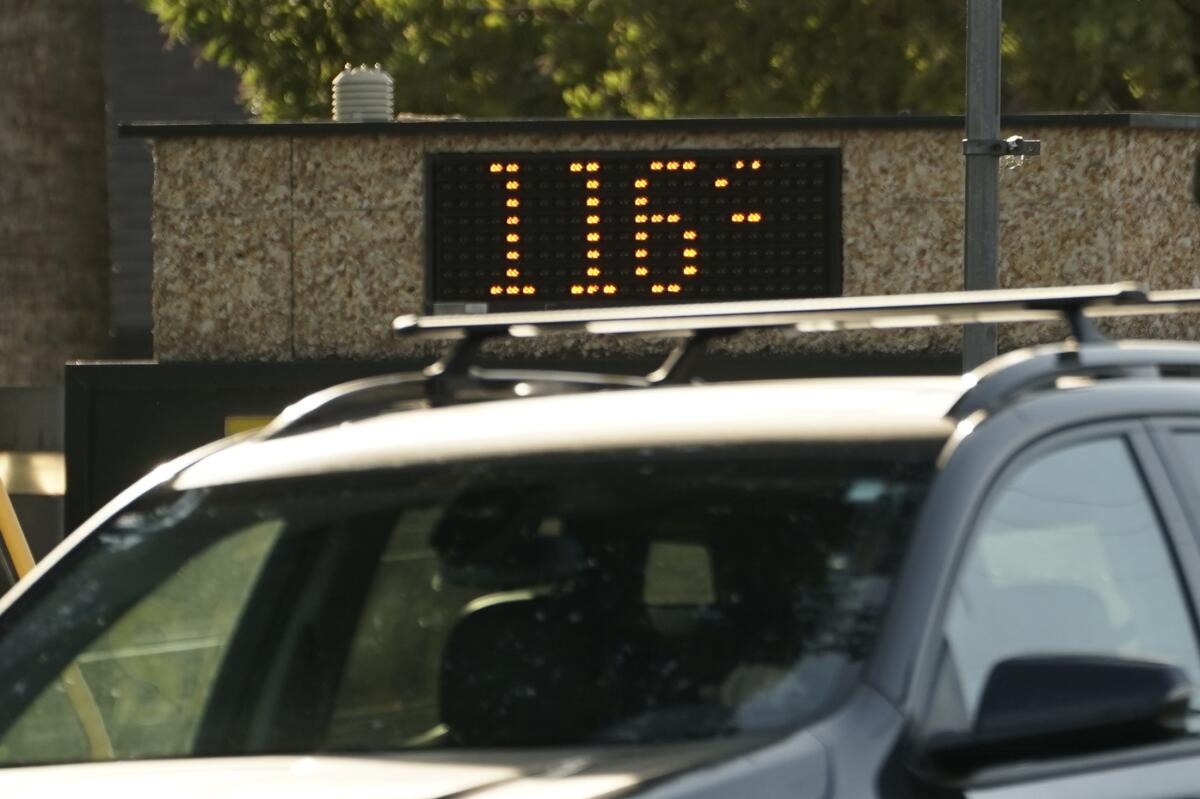
The mayor, who is also a former state Senate leader, envisions some sort of requirement for homeless people to accept shelter when it is offered. Fed up with encampments, other elected leaders across California have echoed at least vague support for the same.
But such a requirement is nonstarter for many activists and civil rights advocates, who argue that personal autonomy is the fundamental right that can’t be compromised — life-threatening heatwaves or not.
Meanwhile, California is sure to get socked with more extreme weather in the coming years, from catastrophic wildfires to tropical storms to giant floods. California has just experienced the longest, hottest stretch of September days in its history, and that’s just the beginning.
Tyson says the heat of Sacramento is worse than the cold and the snow of her native Buffalo, N.Y., where she also was homeless. At least in the cold, she says she had some motivation to move. In the heat, she “can’t do nothing.”
Except wait, and hope California does something.
More to Read
Sign up for Essential California
The most important California stories and recommendations in your inbox every morning.
You may occasionally receive promotional content from the Los Angeles Times.
